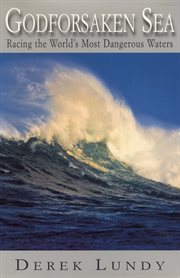Details
PUBLISHED
Made available through hoopla
DESCRIPTION
1 online resource
ISBN/ISSN
LANGUAGE
NOTES
Godforsaken Sea is the hair-raising account of the world's most demanding, dangerous, and deadly sailing race. Around the world, one sailor, one boat, no stops, no assistance. Author Derek Lundy's vivid book follows the field of the 1996 - 1997 Vendee Globe through the race's grueling four-month circumnavigation of the globe, most of it through the terror of the Southern Ocean. Lundy narrates the race through the eyes and experiences of sixteen sailors - fourteen men and two women - who embdoy the best and most eccentric aspects of our human condition. There's the gallant Brit who spends days beating back against the worst seas to save a fellow sailor; the Frenchman who bothers to salvage only a bottle of champagne from his broken and sinking boat; the sailor who comes to love the albatross that trails her for months, naming it Bernard; the sailor who calmly smokes a cigarette as his boat capsizes; and the Canadian who, hours before he disappears forever, dispatches this message: If you drag things out too long here, you're sure to come to grief. With the literary touch of Saint-Exupery and Conrad, Derek Lundy harnesses hurricane-force winds, six story waves, icebergs, and deafening noise. And he lays bare the spirit of the men and women who push themselves to the outer limits of human endeavor - even if it means never returning home. Derek Lundy is an experienced amateur sailor. A lawyer by training and a writer by profession, he is the author of Scott Turow: Meeting the Enemy. He lives in Toronto. In the Seas Entrall an excerpt from Chapter One of Godforsaken Sea: Racing the World's Most Dangerous Waters by Derek Lundy In early January 1997, thirteen Vend,e Globe solo sailors were strung out across six thousand miles of the Southern Ocean, stretching from south of Australia almost to Cape Horn. The sailors had already been at sea for more than two months. Of the sixteen starters, only ten were still officially in the race. Three more kept sailing but had been disqualified for stopping in one port or another along the way to make repairs to their boats-strictly prohibited by the race rules. Dinelli had been sailing as an unofficial entrant because he hadn't had time to make the two-thousand-mile sail required to qualify for the Vend,e Globe. Two racers had withdrawn soon after the start on November 3 of the previous year because of damage suffered in a storm in the Bay of Biscay. Deep in the Southern Ocean, the skippers had lived for weeks in wet foul-weather gear in cold cabins dripping with condensation or wet with seawater that found a way in. The widely spaced boats were dealing with various weather conditions, none of them pleasant. At best, some were running uncomfortably, but not dangerously, before the gale-force depressions that travel unceasingly across the high southern latitudes. For other boats, there wasn't enough wind to enable them to handle the sea conditions-big seas persist for some time after the weather that created them has moderated. The boats were faltering in waves that struck anarchically from all directions without the governing discipline of strong wind. Other skippers found themselves in particularly severe low-pressure systems-storms that made our Virgin Islands "yachtsman's gale" seem like the briefest and most benign of squalls. They were struggling to control their boats as they surfed at breakneck speeds of twenty-five knots or more down waves like steep hills in winds of near-hurricane strength. In just those conditions, during the night of January 4, two of the sixty-foot-long Vend,e Globe boats capsized. They were sailing fourteen hundred miles southwest of the Australian Cape Leeuwin at about fifty-one degrees south latitude-just inside the border of the furious fifties. The boats were within forty miles of each other, near the back of the strung-out fleet. Aboard Exide Challenger (a sophisticated ketch-a two-masted rig), Tony Bullimore heard a lo
Mode of access: World Wide Web







